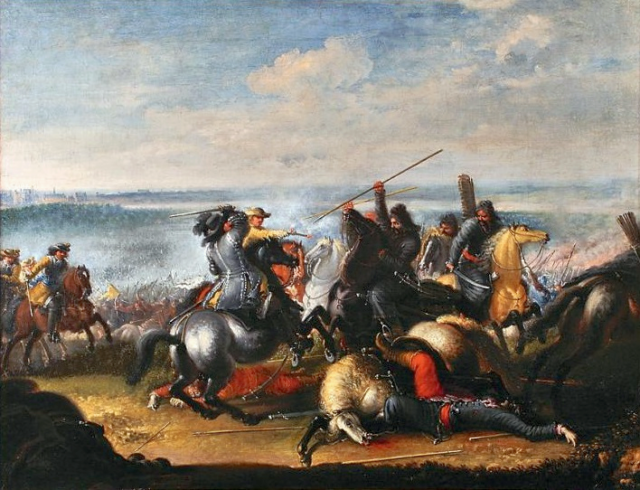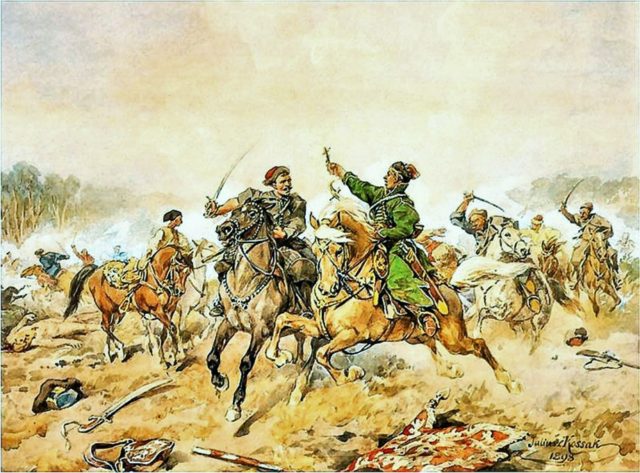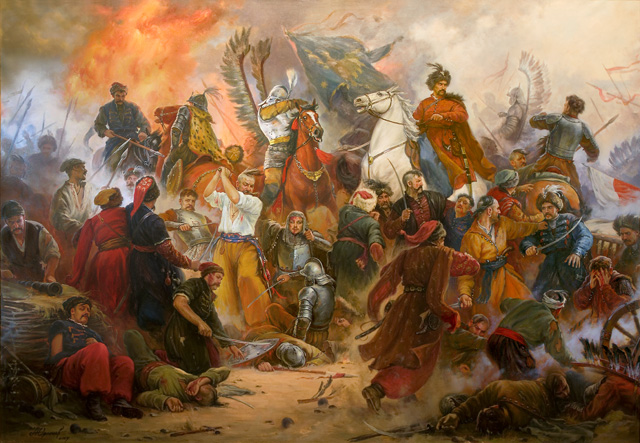The Battle of Berestechko would be a fight against a massive revolt. Although the victory would give a chance for King John Casimir to end the revolt, he would waste that chance, and turn a whole new bloody page in history. That battle would result in the destruction of a European Superpower, countless deaths, and the annexation of an entire country by another unrivaled authority.
Prelude to the Battle of Berestechko
The leader of the revolt, Khmelnytsky, gathered the masses and led them against the Commonwealth for one reason alone. The Orthodox Christians had suffered under the government of the Catholic Polish for far too long.
For five centuries the Ukrainians had to bear being ruled by the Catholics. Thus, the Ukranian Cossacks initiated series of campaigns to free their lands from Polish dependence.
The success of the uprising in the battles of the Zhoti Vody, Korsun and Pylavtsy might release the Ukrainians from Polish rule, but then again, would put them under another one.
Battle of Berestechko
Day I
It was the end of June, the year 1651. A small unit of the Polish cavalry would meet the huge vanguard of the Ukranian uprising. The Polish pancerni and winged hussars would have to stand against the Tatar-Cossack force, which was much bigger. Suffering minimal casualties, the Polish won against the formidable enemy. What would happen from there on would change history.
Day II
On the very next day, the 30th of June 1651, the army of the uprising would take the offensive stance. The Polish, who had exited their camp, preparing to charge the enemy, were instead pushed back and left with no option but to run back. The Polish cavalry was forced to withdraw. The Tatars were repulsed only by the help of the infantry and cavalry’s charge. However, the victory of the second day was in the hand of the Tatars.
Day III
Jan II could not stand and watch the Tatars take one more step and humiliate his forces yet again. Upon his insistence, the third day of the battle, June 30th, the Polish army was ready to meet the enemy in one final decisive clash. The morning air was filled with the sound of marching troops, being deployed by the commanders. The battlefield was shrouded in a fog, which forced both armies to stand and wait for it to lift. At last, in the middle of the afternoon, the battle began.

Jeremi Wiśniowiecki’s right wing rushed to attack the Tatar force, who were driven away from the battlefield. Soon the Cossack infantry was on the verge of total defeat. Not long afterward the enemy Cossacks were routed and ran away with tucked tails under the Polish cannonade. The Crimean Khan took the Cossack leader of the Uprising Khmelnytsky as a hostage and left the battlefield with his disarrayed mass of confused rebels.
The Siege
For the next ten days, the Cossacks were besieged. The Polish engineers use a nearby water source to flood the enemy camp. Realizing their most unfavorable position, the Cossacks sent charge against the besiegers, in a try to open a way for escape. The Cossacks who were in the camp, however, had little to no idea what was happening and began panicking. That gave a huge advantage to the Polish, and they quickly wiped out the enemy army altogether, covering the ground with as much as 20,000 corpses.
Aftermath and Significance of The Battle of Berestechko
With the battle ended, the Polish leader King John Casimir made a critical mistake, which would set in motion events that would drown the soil with blood. Regarded as one of the biggest battles of pre-modern history, Berestechko was an opening for several important moments in history. A battle like no other before WWI.
The Swedish Deluge and the end of the Commonwealth

King Casimir’s mistake to not quench the Khmelnytsky Uprising would begin the Swedish Deluge. The wars with the Commonwealth would cost the lives of 1/3 of its population, destroying the once great power. The Swedish invasion left lands of the Polish-Lithuanian Commonwealth with nothing but destruction.
The invaders flattened to the ground 188 towns and cities in Poland, together with 81 castles and 136 churches. The very capital of the Commonwealth was left almost lifeless, for only a couple of thousand survived the raid of the Swedish invasion. Poland was basically on the verge of complete destruction.
Furthermore, the capital city of Warsaw was depopulated by the battle at the end of July 1656. The riches of the country were stolen.
Although at the end of the Swedish deluge, the victors were the Polish, the costs were immense. Their pyrrhic victory resulted in significant territorial changes, mainly a loss of large portions of land.
The Treaty of Pereiaslav and the Annexation of Ukraine

The war with Russia was another of the devastating events caused by that battle’s unfortunate outcome. After long years of warfare, the result would not be to the taste of Catholic Poland.
The alliance of the Khmelnytsky Uprising with Russia would start a devastating war. The Thirteen Years’ War would continue to drain the already weakened Commonwealth. The internal turmoil and economic crisis would force Poland to give up their authority over a significant piece of land.
On the 18th of January 1654, a treaty was signed. According to the Treaty of Pereiaslav Russia received the right to annex Ukraine. Until that day, it was had been Polish territory. But the alliance of the Cossacks with Moscow played a great role in that war. The Ukrainian Cossacks and their lands were handed over to Moscow.
